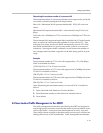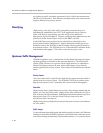
Configuring the 4300T
3 - 45
• Call processing server connectivity status indicators
• Support for multiple call processing servers using DNS
• Reporting of the currently active call processing server in environments
using multiple call processing servers
• Local call switching between VoIP endpoints and premises based PSTN
gateways during WAN link failures or other failures that prevent
connectivity to network based call processing servers
• Calling features such as transfer, hold and conference are provided by
V
2
IU Series appliances
• Simplified setup that creates a local dial plan in the V
2
IU appliance by
monitoring traffic to network based call processing servers
How survivability works
The V
2
IU appliance automatically creates a local dialing plan by monitoring
the registration requests sent by LAN based SIP user agents as they register
with the network based call processing server. In creating this dial plan the
V
2
IU appliance now has knowledge of all local SIP user agents installed on its
LAN interface. This dial plan will be used during fallback mode of operation
when the V
2
IU appliance provides local call switching between user agents
and/or a LAN side PSTN gateway.
V
2
IU appliances continuously monitor the status of connectivity to network
based call processing servers using application layer heartbeat messages.
Configuration settings in V
2
IU appliances control how often messages are sent
to the call processing server and how quickly the server will be declared
unreachable in the event of a failure. The use of application layer messages
provides the added benefit of detecting the failure condition where an V
2
IU
appliance has IP connectivity to the call processing server but the call
processing server software itself is not functioning properly.
Once a call processing server has been declared unreachable V
2
IU appliances
enter fallback mode and perform call processing for local SIP user agents. A
SIP PSTN gateway can also be installed at the branch office on the LAN side of
the V
2
IU appliance and used for inbound and outbound calling during
fallback mode. To maximize utilization of this gateway it can also be used
when call switching is being performed by the network based call processing
server.
Once connectivity to the network based call processing server is restored the
V
2
IU appliance will automatically turn control of all subsequent call requests
over to the softswitch. Calls in progress that were established while the V
2
IU
appliance was in fallback mode will not be disrupted when connectivity is
restored to the network based call processing server.
Redundant or multiple call processing servers can be used in conjunction with
V
2
IU Series appliances to further enhance the availability of voice services.
V
2
IU appliances will use DNS SRV records from a DNS server to obtain a


















